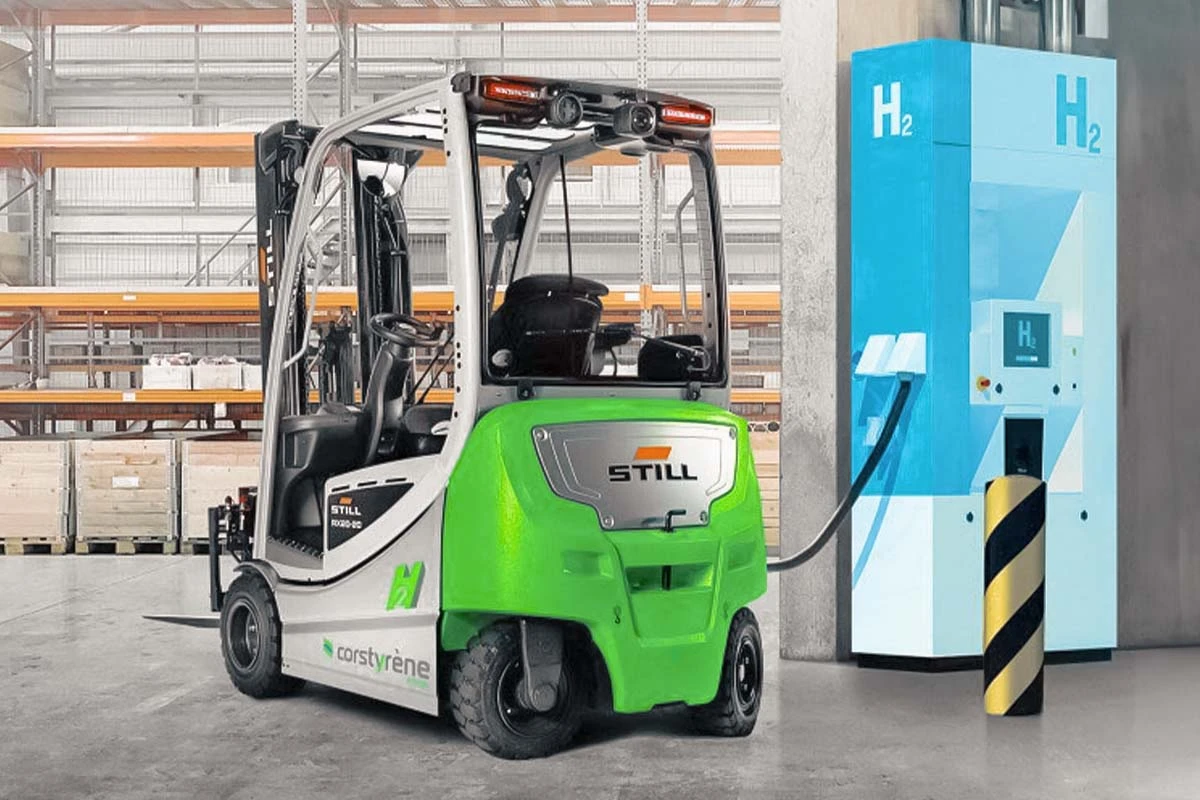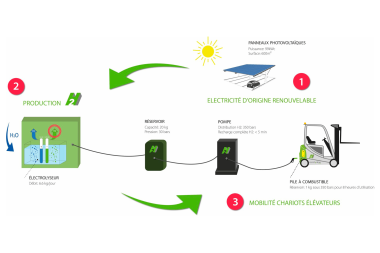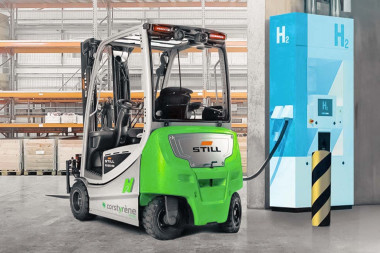Hydrogen forklift truck: Corstyrène relies on STILL
In the second half of 2021, thermal insulation specialist Corstyrène plans to open Corsica's very first green hydrogen plant at its production site in Aléria. The new plant – which will be powered by solar car ports installed in the factory car park – will produce up to 100 kWp and will initially be used to refuel seven RX 20 fuel cell forklifts from STILL.

“Sustainable development is part of our DNA,” explains Estelle Ouzineb, project engineer at Corstyrène. In fact, the very reason the company was founded was to reduce the environmental impact caused by shipping finished insulation panels from the mainland across to Corsica. “When you think that these products are 98% air, it's completely unnecessary to damage the environment in this way.” Later the company also set up a recycling plant to re-purpose polystyrene waste and incorporate this industrial by-product back into the manufacturing process for some of its products. “We are currently running tests to see if we can increase this figure to 50%,” says Estelle Ouzineb.
Investing in future energy solutions
Corstyrène is also a big proponent of renewable energy. In 2010, it installed a solar park (75 kWp) at its production site in Aléria on the east coast of Corsica. Then, in 2020, the company joined forces with Générale du Solaire and invested in the creation of a 3 ha solar park connected to the mains grid. Now Corstyrène is embarking on the next stage in its green revolution – a hydrogen production and distribution plant at its production site in Aléria. The facility has a theoretical capacity of 20 kg/day and will be powered by solar car ports installed in the company car park. “This development actually represents two firsts for Corsica,” explains Estelle Ouzineb, “the first hydrogen plant and the first green hydrogen one at that, so it's completely carbon-neutral.” That's a big plus given that 95% of hydrogen currently available on the market is produced using natural gas. The new plant will be built on an 80 m2 plot adjacent to the Corstyrène factory, so that it can initially be used to refuel seven fuel cell forklifts. The decision about which forklifts to buy was an easy one: “We immediately turned to STILL because they have so much experience in this area. They were able to offer us a package that met our exact brief at a competitive price and within a competitive timescale,” says Estelle Ouzineb.
Recognised experts
“STILL is a frontrunner in the development and operation of fuel cell forklifts,” confirms Christophe Oruzio, Head of Warehousing and the person responsible for fuel cell projects at STILL France, which currently boasts the largest fleet of hydrogen forklifts in Europe (1). “We have a strong reputation as experts in this field and so are regularly invited to advise on and implement projects all over Europe. We’re excited to help expand the green energy infrastructure in Corsica by assisting Corstyrène with the roll-out of its new green forklift fleet.” The seven forklifts (5 x RX-20 16P and 2 x RX-20 18P) will be fitted with a PlugPower type 1510-48 CEA fuel cell (10 kW/48 V) and supplied with a CE declaration of conformity that covers both the forklift and the fuel cell. “Corstyrène will take on the servicing of the forklifts,” explains Christophe Oruzio but PlugPower will be responsible for maintaining the fuel cells. Estelle Ouzineb believes that the transition to hydrogen will give Corstyrène “much greater flexibility in the way it uses its forklift fleet.” And it's easy to see why: the hydrogen trucks take just two minutes to refuel compared to the eight hours needed to recharge the battery in a standard electric truck.
First step in an ambitious project
That said, these gains are just the tip of the iceberg for Corstyrène “because the forklifts are only used as and when needed for transporting raw materials and finished products – the fleet isn't operating day in day out.” So why build it? In fact, the new hydrogen plant is the start of a much larger and more ambitious project. As Estelle Ouzineb explains: “The ultimate aim is to replace all the factory’s forklift trucks (nine in total) and semi-trailers, and also to supply hydrogen fuel for private vehicles via local partnerships.” She believes that, by breaking the process down into stages, Corstyrène “can build up the expertise and industrial capabilities necessary to expand its project on a much larger scale – maybe even eventually supplying green energy to the ports of Bastia and Ajaccio. In the long-term, the project could also potentially see the creation of a depolymerisation plant to process the plastic waste that currently poses such a significant environmental challenge for the island.” (1) STILL is one of the industry partners at the Carrefour site in Vendin-le-Vieil in north-west France, which operates a fleet of 137 STILL fuel cell forklifts.
Green hydrogen vs grey hydrogen
Unlike fossil fuels (such as oil, gas and coal), hydrogen is not a primary energy source. Instead it is an energy carrier, like electricity, which is produced using another energy source. As a form of energy, hydrogen offers many fantastic advantages. However, because it is so lightweight it can be complicated to store, transport and distribute – requiring very low temperatures (-253°C) or very high pressure (700 bar). Grey hydrogen is generated using fossil fuels – usually natural gas in a process called steam methane reforming, which is not exactly carbon friendly. In contrast, green hydrogen is generated in an electrolyzer using electrolysis of water powered by renewable electricity (e.g. solar, wind or hydro).


